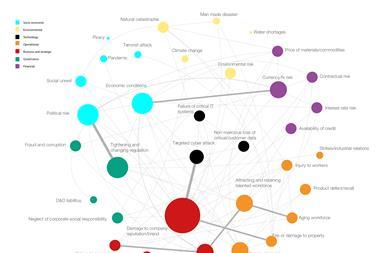What criteria does S&P use when reviewing the Lloyd’s syndicates? Matthew Day explains
The Lloyd's insurance market (Lloyd's or the market) is a unique insurance provider, and needs to be addressed in a way that acknowledges these qualities when it comes to its rating.
Standard & Poor's Ratings Services rates the financial strength of the market (insurer financial strength rating A+/Stable), however, Lloyd's is not an insurance or reinsurance company, but a partially mutualised, competitive marketplace within which buyers of insurance and reinsurance look to have their demand for risk transfer satisfied by risk carriers - the Lloyd's members. The Lloyd's members (or capital providers) are the ultimate risk carriers at Lloyd's. Annually, the capital providers group together to form syndicates in order to accept risk, severally not jointly. It is because of this unique structure that a specialised approach is needed when offering opinions on the individual syndicates.
To address these issues and meet the insurance and capital markets' need for a more specific view of the syndicates, Standard & Poor's does offer an opinion on a syndicate's continuity characteristics in the form of a Lloyd's Syndicate Assessment (LSA). This measures the dependency of syndicates on Lloyd's Central Fund, brand, international licensing agreements, infrastructure, and, ultimately, on the Lloyd's FSR.
Standard & Poor's considers that all syndicates are dependent on Lloyd's to a greater or lesser extent. A syndicate assigned an LSA of '5' is considered to have ‘very low dependency’ and strong business continuity characteristics, which Standard & Poor's views as positive, whereas an LSA of '1' indicates ‘very high dependency’ and weak business continuity characteristics, which are viewed as negative.
LSAs have been welcomed both by syndicate clients and brokers who wish to ensure that continuity of relationships is maintained over the life of the policy and claims period.
Standard & Poor's has assigned an LSA to all syndicates currently trading at Lloyd's that have sufficient relevant data to support a meaningful review. Typically, Standard & Poor's requires financial results from at least three closed underwriting years before assigning an LSA on a 'pi' basis.
LSA analysis – the pi approach
The starting point for all LSA analysis is the result generated by the public information or 'pi' LSA model. Where an LSA is assigned on an interactive basis, additional and confidential information gained through discussion with syndicate management supplements, and supersedes the initial 'pi' analysis.
Since the Lloyd's market moved from a three-year fund to an annual accounting basis, adopting UK GAAP, Standard & Poor's has shifted its prime analytical focus to the annual accounted information disclosed by each syndicate. Three-year fund-accounted information, where disclosed, is still reviewed as part of analytic due diligence, and syndicate three-year fund-accounted track records remain extremely relevant, especially during this transitional period. However, the change in focus was necessary in order to:
• Ensure analytical consistency. Not all syndicates have produced three-year fund accounts for year-end 2005, whereas all have produced these on an annual accounted basis
• Enhance the comparability of Lloyd's syndicates with insurance operations outside of the market.
Standard & Poor's has ensured consistency within the LSA product through extensive testing and calibration of the updated model and through the committee process.
Analysts and LSA committees at all times have the ability to override modelled results where it is felt that the modelled output is not adequately reflective of the information that is available in the public domain.
The LSAs are assessed based on seven heads of analysis, as shown below.
LSA: Heads Of Analysis
Underwriting profile
Investments and liquidity
Reinsurance
Operating performance
Reserves
Capital
Ownership
Interactive LSAs – greater depth
Standard & Poor's interactive LSAs are prepared at the request of the syndicate's management. Key differences from the 'pi' approach include the incorporation within the analysis of dialogue with management and extensive confidential information. Interactive LSAs therefore allow Standard & Poor's to offer a more prospective view on a syndicate's business continuity characteristics.
The risk categories considered in an interactive assessment are the same as those of the 'pi' assessment. The criteria that are applied are drawn largely from Standard & Poor's criteria for rating property/casualty insurance companies.
The 'pi' subscript is removed from the interactive LSA. In addition, to recognise the added depth that full interaction brings to the analysis, the LSA scale includes notches (that is, pluses and minuses), which enhance differentiation between the syndicates. Interactive assessments also carry outlooks (positive, stable, or negative) and can be placed on Watch (positive, developing, or negative).
Latest review
The 2007 midyear review of LSAs saw increased stability in the assessments, despite a number of syndicates posting record returns for 2006, benefiting from the lack of material catastrophic losses. The assessments had already factored in the expected benefits following the hardening of the insurance markets post hurricanes Katrina, Rita, and
Wilma and in a large number of cases the sustainability of the strong turnaround in performance remains untested by more challenging underwriting conditions.
In total, Standard & Poor's assesses 40 out of the 66 syndicates trading in the Lloyd's market (Lloyd's or the market; A+/Stable), 11 on an interactive basis. These 40 syndicates account for 71% of the market's 2007 underwriting capacity (80% in 2006). In addition, two of the unassessed syndicates carry an insurer financial strength rating (FSR), based on an explicit parental guarantee, accounting for a further 6% of capacity.
Standard & Poor's LSAs evaluate the relative dependency of syndicates on Lloyd's infrastructure and Central Fund, reflecting their ability to offer business continuity to policyholders. Standard & Poor's FSR on Lloyd's is the principal measure of financial strength to be applied to all syndicates underwriting in the Lloyd's market. As the LSAs are a relative assessment, they have not been directly affected by the upgrade of the market on April 23, 2007. There may, however, be potential benefits to some syndicates over the medium term as the upgrade means the overall attractiveness of the market has improved.
Currently, only Limit – Syndicate 0386 is assessed at 'LSA 5', indicating a very low level of dependency. Following the latest review, a further seven syndicates are assessed at 'LSA 4', and 17 syndicates assessed at 'LSA 3'. Fifteen syndicates display higher dependency, split between 13 at 'LSA 2' and two at 'LSA 1'. The distribution by capacity is shown in Chart 1, showing that 59% of the market capacity is assessed at an LSA of at least LSA 3, or is guaranteed, with 28% unassessed.
Assessment changes at latest review
Equity Syndicate Management – Syndicate 0218 has been upgraded to 'LSA 4pi' from 'LSA 3pi', reflecting the syndicate's strategic importance to Insurance Australia Group Ltd (main operating entities are rated AA/Stable), the ultimate parent of its majority capital provider.
The two LSA downgrades were Jubilee Managing Agency – Syndicate 0779 (to 'LSA 2pi' from 'LSA 3pi') and AEGIS Managing Agency - Syndicate 1225 (to 'LSA 2pi' from 'LSA 3pi').
One new assessment has been assigned, to Jubilee Managing Agency – Syndicate 1231 ('LSA 2pi'). This assessment has been possible as the syndicate now has a sufficient track record to allow a meaningful opinion to be given.
Following the withdrawal of the assessments on Canopius Managing Agents - Syndicate 0044, Argenta Syndicate Management - Syndicate 2121, and Liberty Syndicate Management – Syndicate 4452, and the commencement of eight new syndicates in the market, 24 syndicates remain unassessed, accounting for 28% of the market's 2007 capacity. Three large syndicates are unassessed to prevent confusion, as they are part of interactively rated groups, and alone account for over 10% of capacity.
Matthew Day is a credit analyst at Standard & Poor’s. He can be contacted on 020 7176 7044 or matthew_day@standardandpoors.com
Downloads
Lloyd's Syndicate key financials 2005-2006
PDF, Size 72.3 kbLloyd's Syndicates key financials 2005-2006 (cont.)
PDF, Size 74.52 kbLloyd's Syndicates business lines 2005-2006
PDF, Size 74.04 kbLloyd's Syndicates business lines 2005-2006 (cont.)
PDF, Size 75.37 kb



















